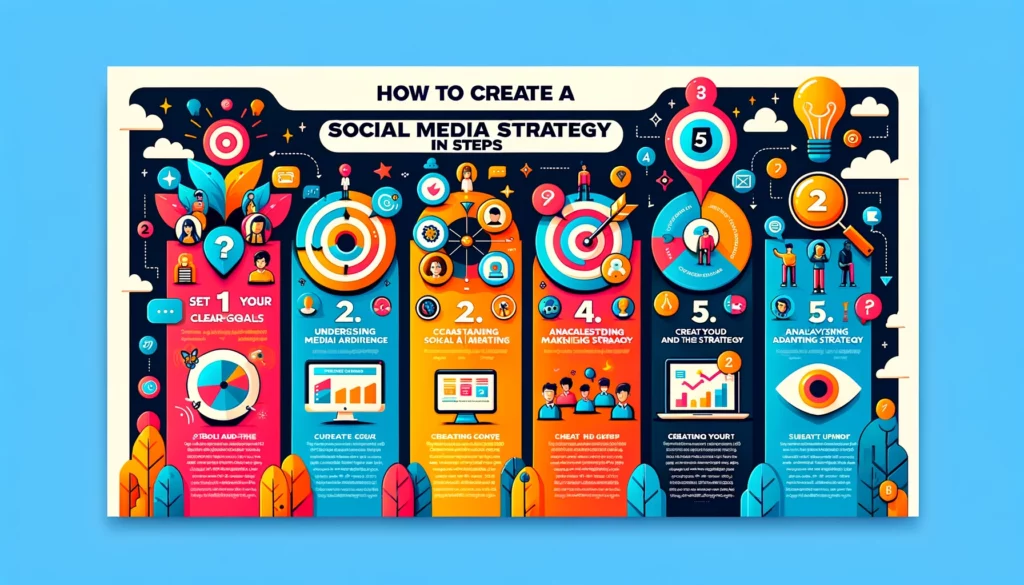Crafting a social media marketing strategy involves outlining your objectives and desired outcomes on various platforms. It serves as a roadmap, steering your efforts and providing benchmarks for success.
Clarity and specificity are critical to an effective plan. Avoid vagueness or overly ambitious goals that are hard to gauge.
Below, we’ll present a concise nine-step guide to help you develop a successful social media strategy tailored to your needs.
What is Social Media Marketing?

Social media marketing involves leveraging social media platforms to advertise, promote, or sell a brand, product, or service.
This form of marketing allows businesses to:
– Foster active communities
– Facilitate sales of products and services
– Gauge brand perception
– Offer customer support through social channels
– Target specific audiences with advertisements
– Analyze performance metrics to refine overall marketing strategies
What is a Social Media Marketing Strategy?

A social media marketing strategy is a comprehensive plan that delineates your objectives on social media platforms, the strategies you’ll employ to accomplish them, and the metrics you’ll use to assess progress.
This strategy should encompass
1. Clear delineation of social media objectives
2. Tactics and approaches to realize these objectives
3. Identification of metrics for tracking progress
4. Inclusion of current and future social media accounts, each with platform-specific goals aligned with broader digital marketing strategies In partnership with a leading digital marketing agency, we will ensure that each platform’s content is optimized to reach target audiences, drive engagement, and support overall brand growth.
5. Establishment of roles and responsibilities within the team
6. Definition of reporting frequency and mechanisms for assessing performance.
7. Collaborating with a Digital marketing agency can significantly enhance the effectiveness of your social media strategy, providing expert insights and resources to achieve your goals.
How To Create A Social Media Marketing Strategy In 5 Steps?

Step 1: Define goals aligned with business objectives
Set S.M.A.R.T. Goals
Begin by establishing clear objectives and goals that align with your business objectives. With these, it’s easier to measure success and ROI.
Ensure your social media marketing goals are SMART: Specific, Measurable, Achievable, Relevant, and Time-bound.
Tip: Need inspiration for SMART social media goals? We’ve got examples to guide you.
SMART goals are:
- Specific: Clearly define what you aim to accomplish on social media, such as increasing brand awareness, driving website traffic, generating leads, or boosting signups/sales.
- Measurable: Establish how you will gauge success using quantifiable metrics. This could involve achieving a specific percentage increase in followers or subscribers, engagement rate, or click-through rate.
- Attainable: Ensure that your goals are realistic and feasible. For instance, aiming to grow a new YouTube channel to 5,000 subscribers within a month may not be achievable if you’re new to video content creation.
- Relevant: Confirm that your goals align with your overarching business objectives. They should contribute directly to the growth and success of your business.
- Time-bound: Set a deadline for achieving your goals to create a sense of urgency and focus. You may work within specific timeframes, such as quarters or months, to track progress effectively.
Step 2: Track Meaningful Metrics
While metrics like followers and likes are easy to track, they often need more substantial value. Instead, focus on metrics such as engagement, click-through rates, and conversions. Consider using AI Social Media Tools to track and analyze data, offering insights like engagement rates, follower demographics, and content performance tailored to each platform.
Consider tracking different metrics for each social media platform tailored to your goals. For instance, if using LinkedIn to drive website traffic, monitor click-throughs. For Instagram brand awareness, track Story views. If advertising on Facebook, measure cost-per-click (CPC).
Step 3: Understand Your Audience Thoroughly
To engage them on social media effectively, it’s crucial to understand them as individuals with distinct needs and preferences.
Essential information to gather about your ideal customer includes:
– Age
– Location
– Income level
– Job title or industry
– Interests
Utilize resources like audience/buyer persona templates to create detailed profiles.
Leverage social media analytics to gain insights into your followers, including demographics and engagement patterns. This data enables you to tailor your strategy and target your audience more effectively.
For example, Jugnoo, a service similar to Uber for auto-rickshaws in India, utilized Facebook Analytics to discover that 90% of their referral users were aged 18-34, with 65% using Android devices. Armed with this information, they optimized their ad targeting, resulting in a 40% referral cost reduction. A Google scraper for search results can also provide valuable insights into the trending topics and keywords your audience is searching for, allowing you to refine your content strategy. Plus, incorporating referral marketing tools can help you efficiently manage and track referrals, driving scalable growth.
Step 4: Conduct A Social Media Audit
Evaluate your current social media presence by addressing these questions:
- Identify successful strategies and areas for improvement.
- Analyze audience engagement to understand who interacts with your content.
- Determine key partnerships that bring value to your brand.
- Identify the social media platforms preferred by your target audience.
- Compare your social media performance against competitors.
Step 5: Identify Impostor Accounts
While conducting your audit, be vigilant for fake accounts utilizing your business or product names.
Imposter accounts threaten your brand, diverting followers who should rightfully engage with your official channels.
Consider pursuing account verification to reassure your audience of your authenticity. Follow these steps to get verified:
What Are You Going To Share On Social Media?

When considering what to share on social media, it’s crucial to refer back to the insights gained from Step 2 to pinpoint the type of content that will resonate most with your audience. This knowledge will inform the creation of your social media content pillars.
Content pillars are central themes or topics around which your content revolves. You may have several pillars, each catering to different aspects of your audience’s interests or needs. These pillars can vary slightly from platform to platform, allowing for a diverse yet focused content strategy.
Understanding your target audience is paramount when defining your content pillars. Referencing the marketing personas created earlier helps ensure that your content effectively addresses your audience’s goals or challenges. If your audience belongs to the ENFJ personality type, you should tailor your content to resonate with their empathetic nature, emphasizing community building.
Evaluate the social media presence of businesses similar to yours, considering factors such as:
- Which platforms are they active on?
- What strategies have proven successful for them?
- Which types of content yield the best results?
- Are there any mistakes they’ve made that you can learn from?
- Are they utilizing influencer marketing effectively?
Where Are You Going To Share?
When deciding where to share your content, selecting the social media platforms that best align with your brand and target audience is essential. With numerous platforms available, it’s impractical to maintain an active presence on all of them. Instead, focus on those where your target demographic is most likely to engage.
To make informed decisions, it’s crucial to understand the demographic composition of the leading social media sites:
- Facebook: This platform tends to attract a slightly higher percentage of men, with the dominant age group being 25 to 34. It offers a diverse user base and extensive reach, making it suitable for various types of content and businesses.
- YouTube is popular among both genders but with a slight male skew, particularly within the 25 to 34 age bracket. As a video-centric platform, it appeals to a broad audience and provides opportunities for long-form content and short, engaging videos.
- Instagram: With a relatively balanced gender distribution, Instagram’s primary user base falls within the 18 to 24 age range, closely followed by 25 to 34-year-olds. Its visual nature makes it ideal for showcasing products, lifestyle content, and behind-the-scenes glimpses of your brand.
- LinkedIn Skewing is slightly male; LinkedIn’s user base primarily comprises professionals aged 25 to 34. It’s a valuable platform for B2B businesses, networking, and sharing industry insights and thought leadership content.
- Twitter (formerly known as X): With a predominantly male user base, Twitter appeals mostly to individuals aged 25 to 34. It’s known for real-time updates, conversations, and trending topics, making it suitable for timely announcements, customer service, and engagement.
- TikTok: This platform boasts an almost equal split between genders, with the dominant age group being 18 to 24. TikTok’s algorithm-driven feed and emphasis on short-form video content make it a favorite among younger audiences, offering opportunities for creativity and virality.
You can tailor your strategy by understanding where your target audience spends their time and what content resonates with them on each platform. This involves choosing the right platforms and adapting your content pillars and formats to maximize engagement and reach. Regularly revisiting your strategy and staying informed about platform updates and algorithm changes will ensure your content remains relevant and practical. Lastly, you can get help with strategic planning consulting to refine your approach and achieve better results.
Social Media Motivations
Understanding the motivations behind social media usage is crucial for crafting an effective marketing strategy. Recent consumer surveys shed light on why people engage with social media platforms:
Social Connection: The primary reason cited by 65% of respondents is to keep up with friends and social connections. This emphasizes the importance of interpersonal relationships and staying connected within social circles.
Entertainment: Nearly half of the respondents (53%) use social media for entertainment. This includes consuming humorous content, engaging with memes, watching videos, and enjoying other forms of entertainment.
Learning: Learning emerges as another significant motivation, with 50% of users using social media platforms to acquire new knowledge and skills. This includes educational content, tutorials, news updates, and informational posts.
Product Discovery: While a smaller percentage (28%) prefer social media to learn about new products or brands, product discovery is still a noteworthy aspect of social media engagement. This indicates that social media platforms are essential for product discovery and brand awareness. Also, using digital marketing campaigns, businesses can make their products more visible and connect with potential customers effectively.
Interestingly, when consumers were asked about their preferred method for researching brands and products, a substantial 41% expressed a preference for using social media channels. This suggests a growing trend in utilizing social media platforms as valuable resources for brand research and product information.
Furthermore, there’s a notable generational difference in social media behavior. Younger generations, particularly Gen Z and Millennials, use social media for brand research. This is unsurprising given their familiarity and comfort with digital platforms and their tendency to be more interconnected online.
When considering the challenges and daily problems of our ideal consumers, we’ll focus on four critical types of individuals who represent the majority of our buyers:
1. Busy Professionals: This group faces the challenge of balancing work and personal life. They often seek efficient solutions to streamline their daily tasks and optimize productivity.
2. Health-conscious Individuals: These consumers prioritize their well-being and seek ways to maintain a healthy lifestyle despite busy schedules. They may need help finding exercise routines, creating meal plans, and managing stress. Planner templates can be a valuable tool to streamline your nutrition goals, ensure balanced eating habits, and make time for essential wellness activities. Additionally, for those seeking holistic wellness experiences, incorporating med spa software solutions can facilitate seamless booking of appointments for rejuvenating treatments and therapeutic services, aiding in their journey towards optimal health and vitality. Integrating these solutions into your med spa business plan ensures a comprehensive approach to efficiency and customer satisfaction.
3. Small Business Owners/Entrepreneurs: This segment faces numerous challenges, including managing finances, marketing their businesses effectively, and staying competitive in their industries. They are constantly seeking resources and strategies to grow their businesses. One solution for small business owners facing challenges in marketing their businesses effectively is marketing outsourcing, which can provide specialized expertise and resources to help them reach their target audience more efficiently.
4. Tech-savvy Millennials: This group is highly connected online and values authenticity, sustainability, and social responsibility. They often seek innovative products and brands that align with their values and lifestyle choices.
To effectively engage our audience, we must create content that resonates with their daily challenges and offers practical solutions. This content should be informative, relatable, and actionable, addressing topics such as time management tips for professionals, healthy recipes and exercise routines for health-conscious individuals, marketing strategies and business insights for entrepreneurs, and sustainable lifestyle tips for tech-savvy Millennials.
Despite its smaller size than the main Facebook page, the group has proven invaluable in driving conversions and fostering community among its members. This underscores the importance of prioritizing community-building efforts on social media platforms to enhance audience engagement and ultimately drive business success.
Incorporating E Commerce
Incorporating e-commerce into our social media strategy is crucial as more consumers turn to social platforms for product discovery and shopping convenience. Here’s how we can leverage social shopping trends to enhance our brand’s online presence:
1. Integrate Social Shopping Tools: With one-fourth of social media marketers reporting greater effectiveness in social shopping tools than traditional e-commerce site strategies, it’s clear that integrating these tools into our social media channels can drive sales. By enabling advanced features including shoppable posts, in-app checkout with an optimized checkout page, and product tagging,and even the ability to embed Facebook feed on website, we can provide a seamless shopping experience for our audience directly within their preferred social apps.
2. Anticipate Consumer Behavior: Most (80%) social media marketers foresee a future where consumers will increasingly purchase directly within social apps rather than on brand websites or through third-party resellers. This underscores the importance of optimizing our social media platforms for e-commerce capabilities and staying ahead of this evolving consumer behavior.
3. Target the Right Audience: By the summer of 2023, 25% of users aged 18 to 44 had already made purchases on social media, so it’s essential to target this demographic effectively. By understanding their preferences, behavior and buying habits using the Microsoft Dynamics CRM Platform, we can tailor our content and product offerings to resonate with them and drive conversions.
To enhance targeting, integrating SMS communication can be highly effective. With the SMS Gateway API, businesses can send personalized messages and transactional alerts, ensuring they reach the right audience at the right time, further driving conversions.
4. Global Expansion: Recognizing that social media shopping is becoming the norm in several countries worldwide, we should explore global expansion and localization opportunities. By adapting our e-commerce strategies to suit the preferences and cultural nuances of different regions, we can tap into new markets and capitalize on the growing trend of social commerce globally.
The comparison of social shopping data from the UK, China, and the US highlights the significant growth and impact of social commerce in different regions:
- UK: Social shopping has experienced steady growth, with 4.1% of the population engaging in this trend by 2023. Anticipated data suggests a further increase in 2024, with a projected growth of approximately 2% in 2025. This indicates a growing social commerce adoption among UK consumers, presenting opportunities for brands to capitalize on this trend and enhance their e-commerce strategies.
- China: The Chinese market stands out with a remarkable adoption of social shopping, as evidenced by around 84% of consumers shopping on social media platforms in 2022. Despite challenges posed by COVID-19, the market reached an impressive milestone of 850 million users in 2021, contributing to a market worth exceeding 2.5 trillion. This underscores the immense potential and scale of social commerce in China, making it a lucrative market for businesses looking to expand globally.
- US: Social commerce in the US has also seen significant growth, with the market generating $68.91 million in 2023, accounting for 5.9% of all online sales. This marks a substantial increase from $39.51 million in 2021, indicating a rapid acceleration of social shopping adoption among US consumers. The growing revenue from social commerce highlights its importance in the US retail landscape and presents opportunities for brands to leverage social media platforms to drive sales and engage with customers.
Optimize your social channels for search
Optimizing your social channels for search is becoming increasingly important as social search gains traction among users. Here’s how you can ensure your social media presence is optimized for search engine visibility:
1. Keywords and Hashtags: Incorporate relevant keywords and hashtags into your posts and bio. These keywords should reflect your brand, products, services, and industry to increase the likelihood of your content appearing in search results. If you are promoting any kind of product related to younger audiences (Gen Z), you can use Gen Z Slang Words in #Hashtags and marketing campaigns to engage with younger audiences. You can also track or find new keywords through SE Ranking.
2. Usernames: Ensure your username is easy to search for and reflects your brand identity. Consistency across all social media platforms helps users find your profiles more easily.
3. Alt-text: When adding alt-text to images, accurately describe the content rather than stuffing it with keywords. Alt-text provides context for visually impaired users and can also improve the visibility of your content in search results. You can enhance your visuals with a free AI image generator from text no sign up, which allows you to create compelling images quickly for optimized alt-text
Annie-Mai Hodge, director and founder of Girl Power Marketing, emphasizes the importance of accurately describing images to enhance visibility in search results.
4. Video Content: Video content is becoming increasingly prominent in search results, with over 30% of desktop searches on Google featuring video carousels and video results. Therefore, being active on platforms like YouTube can boost your brand’s visibility in search results. For example, if a user searches for “best gaming laptops in 2024,” a relevant YouTube video may appear among the search results.
Revolutionizing Social Media Engagement with Wavel AI’s Text-to-Speech Solutions
Wavel AI’s text to speech (TTS) solutions, featuring support for over 40 languages and 250+ AI voices, can revolutionize your social media strategy by enhancing accessibility, engagement, and content diversity. Here’s a comprehensive look at how it can be leveraged across various social media platforms and aspects of your strategy:
1. Enhanced Accessibility
Global Reach: By offering content in multiple languages, Wavel AI helps brands connect with a more comprehensive, global audience across platforms like Facebook, Instagram, and Twitter, breaking language barriers and fostering inclusivity.
Inclusivity for All: The range of AI voices makes content accessible to people with visual impairments or reading difficulties, ensuring everyone can engage with your content on YouTube, LinkedIn, and beyond.
2. Diverse Content Creation
Audio Posts and Stories: Transform text updates, blog summaries, or articles into audio formats for Instagram stories, Facebook posts, or tweets, appealing to users who prefer listening to content.
Engaging User Experiences: Utilize varied AI voices to match the tone and personality of your brand or message on platforms like TikTok or Snapchat, creating more personalized and relatable content.
3. Operational Efficiency
Rapid Content Production: TTS technology facilitates the quick conversion of written content into audio, streamlining content creation for regular updates on social media platforms.
Simplified Content Creation Process: Without professional recording setups or voice actors, high-quality audio content becomes effortless and cost-effective, perfect for platforms requiring frequent updates like Twitter and Instagram.
4. Innovative Marketing and Advertising
Personalized Audio Ads: Create targeted and personalized audio ads for platforms like Spotify and Pandora, using different languages and voices to cater to specific demographics or regions.
Consistent Brand Voice Across Platforms: Maintain a consistent brand voice across all social media content, from YouTube videos to Facebook posts, reinforcing brand identity and recognition.
5. Educational Content Enhancement
E-Learning on Social Media: Leverage TTS to produce accessible e-learning content on platforms like YouTube or LinkedIn, making complex information more accessible to digest and engage with.
Informative Podcasts: As businesses publish blogs to improve the SEO of the website. In the same way, you can transform blog posts or articles into podcasts for platforms like Spotify or Apple Podcasts, catering to the growing audience of listeners who prefer educational or informative content.
6. SEO and Content Discovery
Enhanced SEO with Audio Transcripts: Accompany audio content with transcripts on platforms like your website or YouTube to improve searchability and SEO performance.
Algorithmic Advantage: Utilize audio content to gain favor with the algorithms of platforms like Facebook and Instagram, potentially increasing your content’s visibility and engagement using professional SEO services. including SEO for startups to drive targeted organic growth.
7. Platform-Specific Use Cases
Instagram and Facebook Stories: Use TTS to add voiceovers to stories, making them more engaging and accessible.
Twitter Audio Tweets: Create audio versions of tweets for users who prefer listening, enhancing accessibility and engagement.
YouTube Video Narrations: Use TTS for video narrations, making content production faster and more resource-efficient.
LinkedIn Articles: Convert articles into audio format, allowing professionals to consume content on the go.
Conclusion
In conclusion, integrating Wavel AI’s text-to-speech technology into your social media strategy offers a groundbreaking approach to engaging with your audience globally. This innovative solution not only transcends language barriers and enhances content accessibility but also diversifies the types of content you can share across various platforms. From creating more inclusive content that reaches individuals with different needs to streamlining the content creation process for operational efficiency, Wavel AI equips you with the tools necessary for a dynamic and impactful social media presence. By leveraging over 40 languages and 250+ AI voices, you can craft personalized, engaging, and accessible content that resonates with a broader audience. Embrace the future of social media engagement with Wavel AI’s text-to-speech solutions and watch your brand’s reach, inclusivity, and engagement soar to new heights.
Frequently Asked Questions
A social media strategy is a comprehensive plan outlining your business goals on social media platforms, the tactics you’ll use to achieve them, the metrics you’ll track to measure your progress, and the types of content you’ll post. It’s crucial because it ensures your social media efforts are aligned with your broader business objectives, helps you target your desired audience more effectively, and maximizes your ROI from social media marketing.
To create a social media marketing plan, define your goals and objectives. Research your target audience to understand their preferences and behaviors. Choose the right social media platforms where your audience is most active. Develop a content strategy that aligns with your brand identity and audience interests. Finally, set key performance indicators (KPIs) to measure your plan’s success and adjust your strategy based on analytics and feedback.
Effective social media marketing tactics include creating engaging and relevant content, utilizing video and live streaming, leveraging user-generated content, running social media ads, engaging with your audience through comments and messages, using hashtags strategically, and partnering with influencers. Another valuable tool that can enhance your social media marketing efforts is the auto forward app, you can save time and ensure a consistent flow of content that resonates with your audience. These tactics can help increase your brand’s visibility, engagement, and conversions on social media platforms. Additionally, employing creative analytics to track and optimize your strategies can provide deeper insights and drive better results.
Regularly analyze your performance data to improve your social media marketing strategy and understand what’s working and what’s not. Experiment with different types of content, posting schedules, and engagement strategies to see what resonates best with your audience. Stay updated with social media trends and platform updates to adapt your plan accordingly. Engaging with your audience and building a community around your brand can also significantly enhance your social media presence.
A social media strategy template should include sections for your business objectives, target audience analysis, competitor analysis, platform selection, content strategy (including types of content, posting frequency, and content calendar), engagement strategy, advertising plan (if applicable), metrics and KPIs for performance evaluation, and a section for ongoing review and adjustment. This template serves as a roadmap for your social media efforts and ensures all aspects of your strategy are well-planned and integrated.

.webp)






